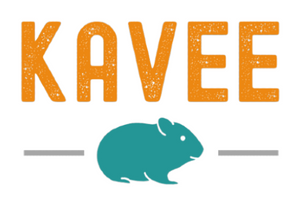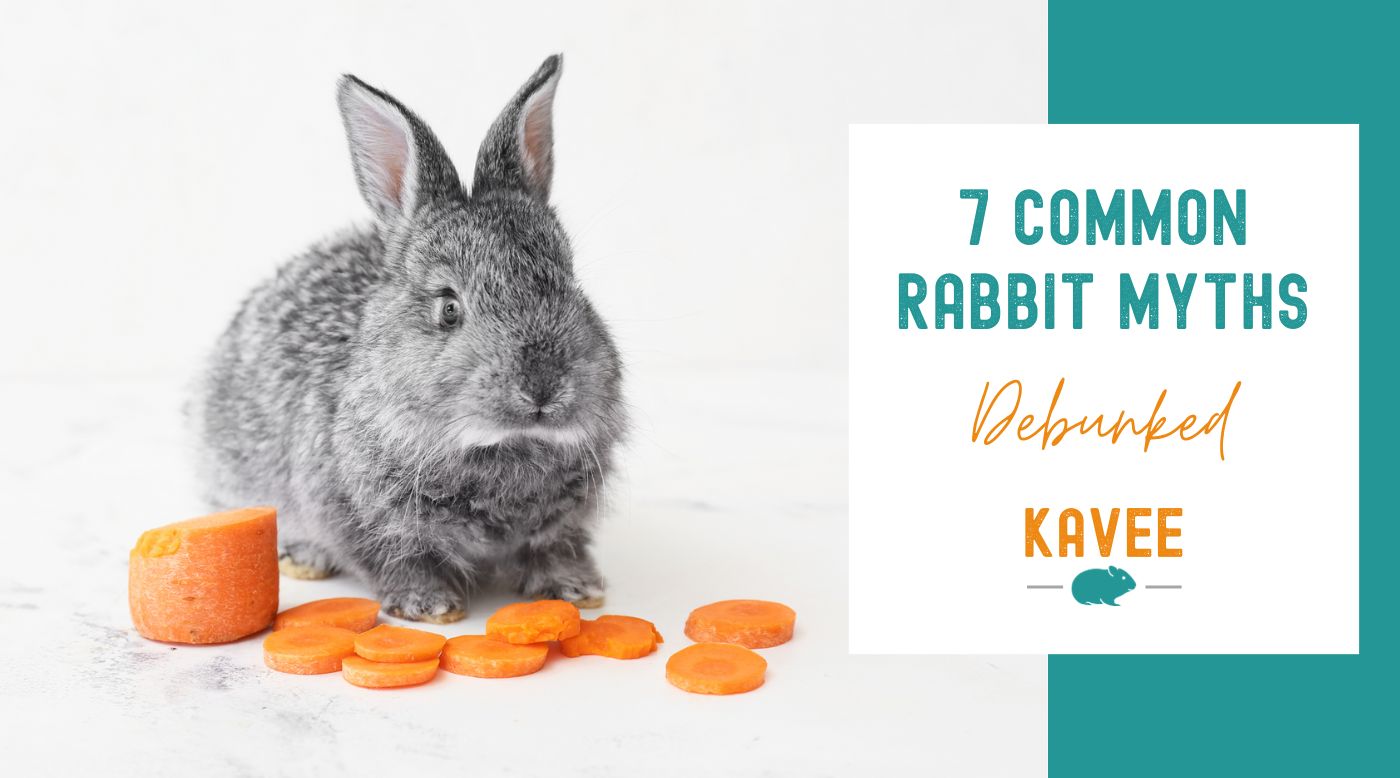Rabbits eat carrots, live alone in small wooden hutches, and are low-maintenance pets... Right?
Well, not exactly. A lot of what we’re led to believe about our furry friends - whether through cartoons or how we’ve traditionally seen them kept as pets - simply isn’t true! And, when we don’t understand our rabbits properly, this sadly means we run the risk of not giving them exactly what they need to thrive (no matter how good our intentions are).
Here at Kavee, we are on a mission to raise the living standards of bunnies. So let’s get to grips with the facts and bust some of the most common rabbit myths, once and for all!

Myth 1: Rabbits Are Low-Maintenance Pets
Many people might assume that since bunnies are quite small, they will require less responsibility and daily care. However, rabbits have their own particular needs just like any other animal, and still require dedicated time and care.
In other words, you can’t just stick a rabbit in a cage and forget about them! Rabbits are inquisitive, adventurous, and intelligent floofs that need daily interaction with their favorite hooman companion - not to mention daily and weekly cleaning, regular feeding, time to exercise, and trips to the vets.
You should only adopt some beloved buns if you’re confident you can give them all the energy and attention they deserve (check out our complete rabbit care guide for a realistic overview of what you can expect).

Myth 2: Rabbits Don't Need Much Space
One of the most pervasive (and damaging) rabbit care myths is that they can live in cramped hutches. A small living environment leaves them with no room to display their natural bunny behaviors, whether hopping, foraging, rearing up on their hind legs, or stretching.
Rabbits are natural athletes and need plenty of space. At the bare minimum, the right rabbit cage size for two small-medium-sized bunnies is at least 12 square feet, with 4-5 hours of daily access to a larger exercise area.
This helps to keep them in shape - preventing health issues like obesity, muscle atrophy, and heart problems - as well as giving them mental enrichment and stimulation.

Myth 3: A Diet of Only Carrots and Lettuce is Enough for Rabbits
Before you go all-out on the root veggies and iceberg lettuce - stop! While you may see them enjoying this diet in cartoons, carrots are high in sugar and should only be given in moderation. While iceberg lettuce is actually not good for anybunny as it contains lactucarium, a harmful chemical to rabbits!
A balanced and nutritious rabbit diet is essential for their long-term health and hoppiness, so check out our complete guide to rabbit nutrition if you’re in need of some expert advice. The majority of a bunny’s diet should consist of hay, while vegetables should be considered as treats and only given in moderation.

Myth 4: Rabbits Don't Live Very Long
According to the Guinness World Records, the oldest ever rabbit recorded was a wild bun called Flopsy, who made it just shy of 19 years old! While this isn’t the reality for most bunnies, don’t be fooled into thinking that owning bunnies is a short-term commitment.
A few decades ago, ‘old age’ for rabbits was commonly considered to be around 5-7 years. However, thanks to huge improvements in how we care for these small animals, the average lifespan of a rabbit has now increased to as much as 8-12 years.
A rabbit’s lifespan can be affected by a variety of different factors:
- Breed - for example, you’ll typically have 4-6 years with a Giant Continental, however, a Mini Rex could live for up to 12 years.
- Diet - a nutritionally balanced rabbit diet will be healthier and reduce the chances of disease and illness.
- Healthcare - Vaccinating your rabbits and bringing them to the vet whenever they display certain symptoms could increase their lifespan.
- Living conditions - a rabbit that lives in clean conditions with plenty of space to move around and exercise is more likely to reach an older age.

Myth 5: Rabbits like cuddles
As cute and fluffy as they may be, our favorite floofs don’t particularly enjoy being picked up or cuddled! This isn’t anything personal - as prey animals in the wild, rabbits are simply more likely to feel stressed over being picked up and cuddled.
Instead of showing your affection in a hooman way, try the bunny way. Give them their favorite veggies as a treat, and plenty of toys to play with. And don’t worry, some bunnies may be more than happy to hop your way and snuggle up on your lap.
Just make sure that it comes from them, rather than force them to cuddle! That’s why when it comes to kids and rabbits, it’s important to teach children to be mindful of the bunnies’ wishes and ensure they respect their personal space.

Myth 6: Rabbits can happily live alone
In the wild, rabbits live in large family groups of up to 20 or even 30 bunnies, so social interaction is high on their agenda. While there may be the odd occasion where it’s kinder to keep a bunny on their own, this is definitely the exception to the rule.
No matter how much TLC you bestow upon your bunny, nothing can replace the company of a fluffy friend. Living with another bunny (or more) will keep them happy, less stressed, and healthier.
Bonded rabbits will enjoy grooming each other, snacking together, and cuddling up at bedtime - an adorable sight to behold! Check out our guide to socializing rabbits if you want to learn more about bunny friendships.

Myth 7: Rabbits can live with guinea pigs
If you love piggies and bunnies as much as we do, then we’d forgive you for wanting to bring two of your favorite floofs together! In the past, before rabbits were typically neutered, they were often kept with guinea pigs to give them some companionship and avoid unwanted pregnancies.
However, it’s now widely acknowledged by pet experts that rabbits and piggies don’t get along too well. This is because it’s easy for rabbits to misinterpret a piggy’s body language and end up bullying their little companion.
Plus, rabbits carry bacteria that can be dangerous to piggy’s immune system. So it’s really safest all around to keep separate C&C cages and house each with their own kind.

Conclusion
Hopefully, you’re now feeling more enlightened about what your bunnies actually need to live long, happy, and healthy lives. It’s really important to differentiate between the rabbit myths and facts so that you can properly cater to their specific needs.
For more articles that give you up-to-date and accurate info, bust common rabbit care myths and that always have the well-being of your furry friends as a priority, check out our bunny blog.
Plus, for binkying buns, ensure you provide them the correct rabbit cage size with our range of C&C cages, and enrich their lives with our variety of liners.



